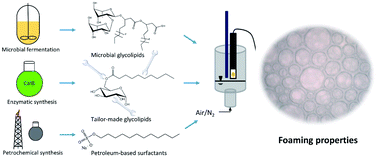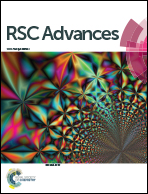Comparative study on interfacial and foaming properties of glycolipids in relation to the gas applied for foam generation†
Abstract
Glycolipids are biosurfactants with a wide range of structural diversity. They are biodegradable, based on renewables, ecocompatible and exhibit high surface activity. Still, studies comparing glycolipids and conventional surfactants in terms of interfacial properties and foaming performance are lacking. Here, we compared interfacial and foaming properties of microbial and enzymatically synthesized glycolipids to those of the widely-used, conventional surfactant sodium dodecyl sulfate (SDS). The enzymatically produced sorbose monodecanoate, as well as microbially produced di-rhamno-di-lipids exhibited high foam stabilizing properties, similar to those of SDS. However, sophorolipid and mono-rhamno-di-lipids did not produce metastable foams. An appropriate selection of head and tail groups depending on the application of interest is therefore necessary. Then, glycolipids can serve as an ecofriendly and efficient alternative to petroleum-based surfactants, even at substantially lower concentrations than e.g. SDS. Moreover, the influence of three foaming gases on the foaming properties of the glycolipids was evaluated. Slightly higher foam stability and lower coarsening rates were determined for sorbose monodecanoate when using nitrogen as the foaming gas instead of air. Foams generated with carbon dioxide were not metastable, no matter which surfactant was used.



 Please wait while we load your content...
Please wait while we load your content...